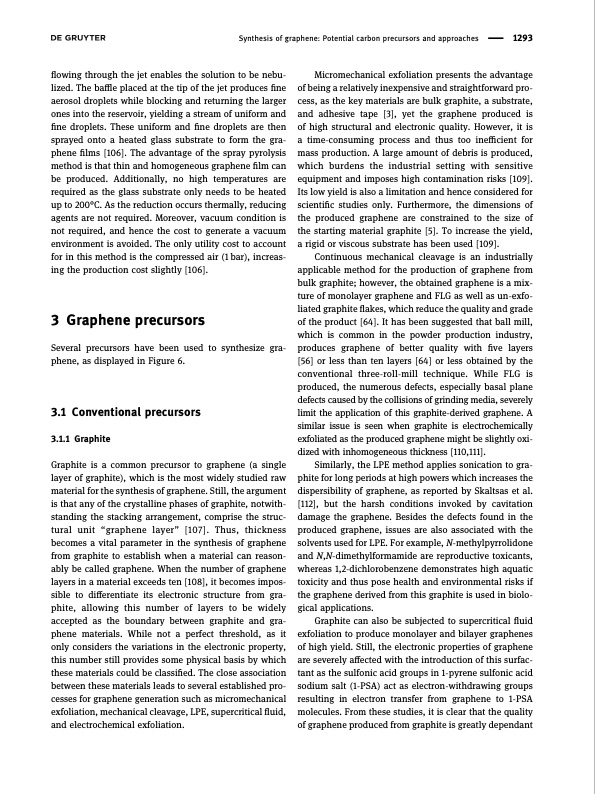
PDF Publication Title:
Text from PDF Page: 010
Synthesis of graphene: Potential carbon precursors and approaches 1293 flowing through the jet enables the solution to be nebu- lized. The baffle placed at the tip of the jet produces fine aerosol droplets while blocking and returning the larger ones into the reservoir, yielding a stream of uniform and fine droplets. These uniform and fine droplets are then sprayed onto a heated glass substrate to form the gra- phene films [106]. The advantage of the spray pyrolysis method is that thin and homogeneous graphene film can be produced. Additionally, no high temperatures are required as the glass substrate only needs to be heated up to 200°C. As the reduction occurs thermally, reducing agents are not required. Moreover, vacuum condition is not required, and hence the cost to generate a vacuum environment is avoided. The only utility cost to account for in this method is the compressed air (1 bar), increas- ing the production cost slightly [106]. 3 Graphene precursors Several precursors have been used to synthesize gra- phene, as displayed in Figure 6. 3.1 Conventional precursors 3.1.1 Graphite Graphite is a common precursor to graphene (a single layer of graphite), which is the most widely studied raw material for the synthesis of graphene. Still, the argument is that any of the crystalline phases of graphite, notwith- standing the stacking arrangement, comprise the struc- tural unit “graphene layer” [107]. Thus, thickness becomes a vital parameter in the synthesis of graphene from graphite to establish when a material can reason- ably be called graphene. When the number of graphene layers in a material exceeds ten [108], it becomes impos- sible to differentiate its electronic structure from gra- phite, allowing this number of layers to be widely accepted as the boundary between graphite and gra- phene materials. While not a perfect threshold, as it only considers the variations in the electronic property, this number still provides some physical basis by which these materials could be classified. The close association between these materials leads to several established pro- cesses for graphene generation such as micromechanical exfoliation, mechanical cleavage, LPE, supercritical fluid, and electrochemical exfoliation. Micromechanical exfoliation presents the advantage of being a relatively inexpensive and straightforward pro- cess, as the key materials are bulk graphite, a substrate, and adhesive tape [3], yet the graphene produced is of high structural and electronic quality. However, it is a time-consuming process and thus too inefficient for mass production. A large amount of debris is produced, which burdens the industrial setting with sensitive equipment and imposes high contamination risks [109]. Its low yield is also a limitation and hence considered for scientific studies only. Furthermore, the dimensions of the produced graphene are constrained to the size of the starting material graphite [5]. To increase the yield, a rigid or viscous substrate has been used [109]. Continuous mechanical cleavage is an industrially applicable method for the production of graphene from bulk graphite; however, the obtained graphene is a mix- ture of monolayer graphene and FLG as well as un-exfo- liated graphite flakes, which reduce the quality and grade of the product [64]. It has been suggested that ball mill, which is common in the powder production industry, produces graphene of better quality with five layers [56] or less than ten layers [64] or less obtained by the conventional three-roll-mill technique. While FLG is produced, the numerous defects, especially basal plane defects caused by the collisions of grinding media, severely limit the application of this graphite-derived graphene. A similar issue is seen when graphite is electrochemically exfoliated as the produced graphene might be slightly oxi- dized with inhomogeneous thickness [110,111]. Similarly, the LPE method applies sonication to gra- phite for long periods at high powers which increases the dispersibility of graphene, as reported by Skaltsas et al. [112], but the harsh conditions invoked by cavitation damage the graphene. Besides the defects found in the produced graphene, issues are also associated with the solvents used for LPE. For example, N-methylpyrrolidone and N,N-dimethylformamide are reproductive toxicants, whereas 1,2-dichlorobenzene demonstrates high aquatic toxicity and thus pose health and environmental risks if the graphene derived from this graphite is used in biolo- gical applications. Graphite can also be subjected to supercritical fluid exfoliation to produce monolayer and bilayer graphenes of high yield. Still, the electronic properties of graphene are severely affected with the introduction of this surfac- tant as the sulfonic acid groups in 1-pyrene sulfonic acid sodium salt (1-PSA) act as electron-withdrawing groups resulting in electron transfer from graphene to 1-PSA molecules. From these studies, it is clear that the quality of graphene produced from graphite is greatly dependantPDF Image | Synthesis of graphene Potential carbon precursors

PDF Search Title:
Synthesis of graphene Potential carbon precursorsOriginal File Name Searched:
10-1515-ntrev-2020-0100.pdfDIY PDF Search: Google It | Yahoo | Bing
Salgenx Redox Flow Battery Technology: Power up your energy storage game with Salgenx Salt Water Battery. With its advanced technology, the flow battery provides reliable, scalable, and sustainable energy storage for utility-scale projects. Upgrade to a Salgenx flow battery today and take control of your energy future.
| CONTACT TEL: 608-238-6001 Email: greg@infinityturbine.com | RSS | AMP |